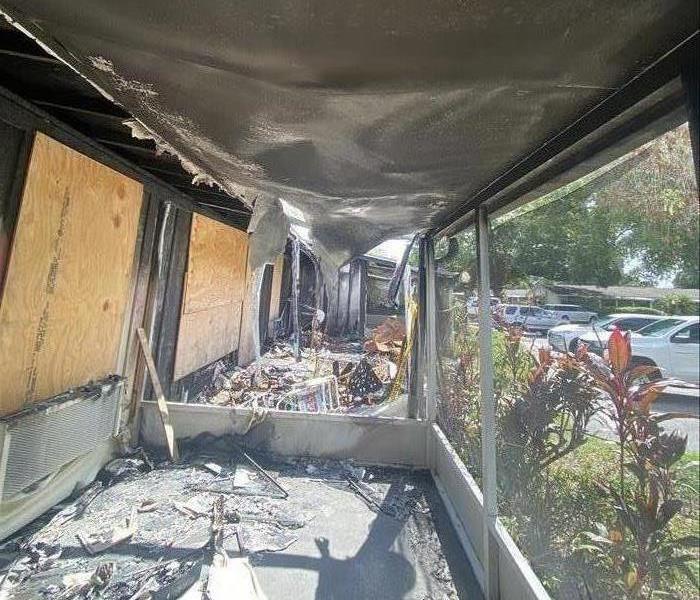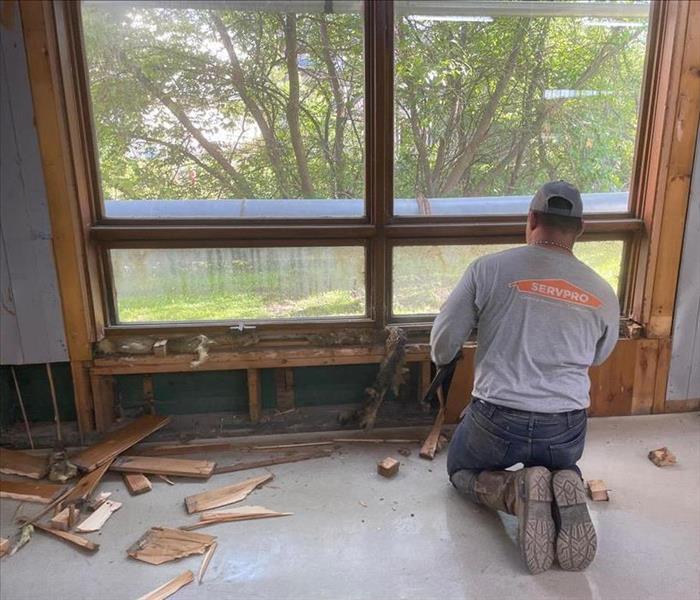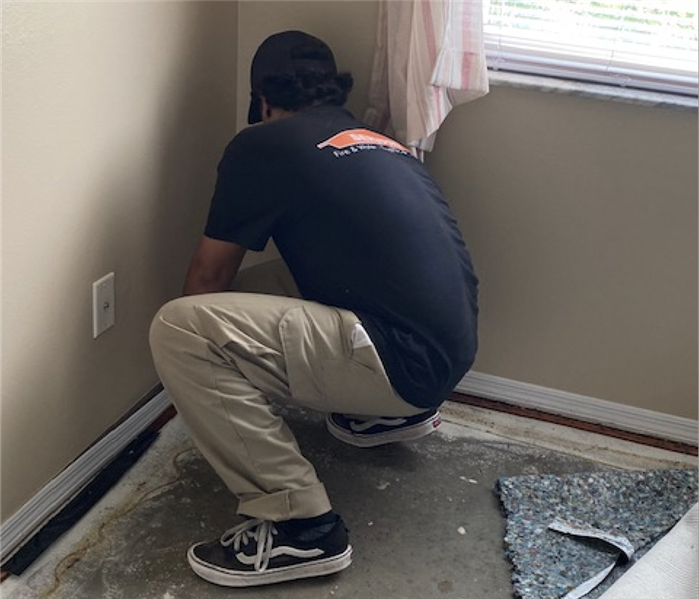Recent Mold Remediation Posts
Bathroom Mold: Causes, Prevention, and Removal – Expert Insights from SERVPRO®
11/13/2024 (Permalink)
 In this blog, we'll explore the main causes of bathroom mold, expert strategies for prevention, and effective removal techniques.
In this blog, we'll explore the main causes of bathroom mold, expert strategies for prevention, and effective removal techniques.
Bathroom mold is a common issue that many homeowners face in Florida. Due to the moisture-rich environment of bathrooms, they can be a prime breeding ground for mold growth. From unsightly discoloration on grout and tiles to the damage it can cause to walls and ceilings, bathroom mold is a serious problem that should not be ignored. In this blog, we'll explore the main causes of bathroom mold, expert strategies for prevention, and effective removal techniques to help keep your bathroom mold-free.
What Causes Mold in the Bathroom?
Mold thrives in areas where moisture and organic material (such as soap residue, dust, and skin cells) combine. Bathrooms, with their frequent exposure to water, warmth, and humidity, are an ideal environment for mold to develop. Here are the most common causes of bathroom mold:
- Excess Humidity: Bathrooms are naturally humid due to activities like showering and bathing. When humidity levels exceed 60%, mold spores can easily take root on damp surfaces like walls, ceilings, tiles, and even under sinks.
- Poor Ventilation: If your bathroom doesn’t have proper ventilation, moisture from showers and baths can become trapped in the room. This lingering moisture leads to condensation on walls and windows, creating the perfect breeding ground for mold.
- Leaky Fixtures: Mold can also develop when there are leaks from faucets, toilets, or pipes. Even a small, undetected leak can lead to significant moisture buildup, which, in turn, encourages mold growth behind walls, under flooring, or within cabinets.
- Soap Residue and Organic Debris: Soap scum, dirt, and other organic matter often accumulate on tiles, grout, and other surfaces. These materials provide mold with the nutrients it needs to grow.
How to Prevent Mold in the Bathroom
While mold is a common problem in bathrooms, there are several steps you can take to prevent its development. The key is controlling moisture and maintaining a clean environment. Here are expert tips for preventing bathroom mold:
- Ensure Proper Ventilation: One of the best ways to prevent mold is to ensure that your bathroom is well-ventilated. Install an exhaust fan and run it during and after showers or baths to help remove excess moisture. Keeping windows open can also help with air circulation, reducing the buildup of humidity.
- Use a Squeegee: After showering, use a squeegee to remove water from tiles, shower doors, and walls. This simple step can help reduce moisture and prevent mold from forming on wet surfaces.
- Fix Leaks Promptly: Regularly check your bathroom for leaks under the sink, around the toilet, or from the shower. If you notice any leaks, fix them immediately to prevent moisture from collecting in hidden areas.
- Use Mold-Resistant Products: When renovating or updating your bathroom, consider using mold-resistant paint, grout, and caulk. These materials are specifically designed to withstand the high-humidity environment of bathrooms and prevent mold growth.
- Reduce Humidity Levels: To further reduce humidity in your bathroom, consider using a dehumidifier, especially if you live in a humid climate. This can help keep moisture levels low, which in turn reduces the chance of mold growth.
How to Remove Mold from the Bathroom
If mold has already started to grow in your bathroom, it’s important to take swift action to remove it and prevent further growth. Here’s how you can effectively remove mold from your bathroom:
- Clean Surfaces Regularly: Regular cleaning is essential to keep mold at bay. Use a bathroom cleaner with mold-killing properties to scrub surfaces like tiles, grout, and shower doors. A mixture of vinegar and water can also work as a natural solution for cleaning mold.
- Remove and Replace Moldy Caulk or Grout: If mold has penetrated your caulk or grout, cleaning may not be enough. In such cases, it's best to remove and replace the mold-infested sections to prevent further spreading.
- Use a Mold Remover for Stubborn Areas: For more stubborn areas of mold, use a commercial mold remover designed for bathroom surfaces. Be sure to follow the manufacturer’s instructions and test the product on a small area first.
- Deep Cleaning with SERVPRO®: If the mold growth is extensive or if it's located in hard-to-reach areas, such as behind walls or under flooring, it's time to call in the professionals. SERVPRO offers specialized mold remediation services to safely and effectively remove mold from bathrooms and other parts of your home. Our experts use advanced equipment and cleaning solutions to ensure thorough mold removal, helping to prevent future growth.
The Importance of Early Detection
Catching mold early is key to minimizing damage and preventing it from spreading. According to the Environmental Protection Agency (EPA), mold can start to grow on wet surfaces within 24-48 hours. Regularly inspecting your bathroom for signs of mold and addressing leaks and moisture issues promptly can save you from costly repairs in the future.
Trust SERVPRO for Expert Mold Remediation
When it comes to bathroom mold, prevention and quick action are crucial. However, if mold becomes a persistent issue or spreads beyond your control, SERVPRO is Here to Help®. Our team of mold remediation experts is equipped with the knowledge, tools, and expertise to handle any mold problem, no matter how severe. We’ll work to not only remove the mold but also help you identify and address the root causes, ensuring your bathroom remains clean and mold-free.
With our professional services, you can trust that your bathroom will be restored to its original condition, allowing you to enjoy a clean and healthy space. Contact SERVPRO today for expert bathroom mold removal and remediation services.
Preventing bathroom mold requires vigilance and consistent moisture control. By following these expert tips, you can significantly reduce the chances of mold growing in your bathroom and keep your home safe from mold damage.
Understanding Mold in Your Attic: Causes and Effective Solutions
7/10/2024 (Permalink)
 We delve into the causes of mold in your attic and provide practical solutions for preventing and remedying this issue.
We delve into the causes of mold in your attic and provide practical solutions for preventing and remedying this issue.
Mold growth in the attic is a common problem faced by many homeowners. The attic provides an ideal environment for mold to thrive, with its dark, warm, and often humid conditions. In this blog post, we'll delve into the causes of mold in your attic and provide practical solutions for preventing and remedying this issue.
Causes of Mold in the Attic
Poor Ventilation:
One of the primary causes of mold in the attic is poor ventilation. Inadequate airflow allows moisture to accumulate, creating a damp environment that promotes mold growth. Without proper ventilation, humidity levels in the attic can rise, especially during hot and humid weather.
Roof Leaks and Water Intrusion
Roof leaks and water intrusion are common culprits behind mold growth in the attic. A leaking roof, damaged flashing, or compromised seals around vents and chimneys can allow water to penetrate into the attic space. Even minor leaks can lead to significant moisture buildup over time, providing ideal conditions for mold to flourish.
Insufficient Insulation
Insufficient insulation in the attic can contribute to mold growth by allowing warm, moist air from the living space below to penetrate into the attic. When warm air meets the cooler surfaces of the attic, condensation can form, creating moisture that promotes mold growth on insulation, wood framing, and other materials.
Blocked Attic Vents
Blocked or inadequate attic vents can impede airflow and exacerbate moisture buildup in the attic. Blocked vents can result from debris accumulation, improper installation, or damage to the venting system. Without proper ventilation, moisture becomes trapped in the attic, creating an environment conducive to mold growth.
Solutions for Mold in the Attic
- Improve Attic Ventilation: Address poor ventilation by installing additional vents or improving existing ventilation systems in the attic. Ridge vents, soffit vents, gable vents, and attic fans can help promote airflow and reduce moisture buildup.
- Repair Roof Leaks and Water Intrusion: Address any roof leaks or water intrusion issues promptly to prevent further moisture infiltration into the attic. Repair damaged roofing materials, flashing, and seals to ensure a watertight barrier against the elements.
- Upgrade Attic Insulation: Improve attic insulation to prevent warm, moist air from entering the attic space. Proper insulation helps maintain consistent temperatures and reduces the risk of condensation and moisture buildup that can lead to mold growth.
- Clear Attic Vents and Ensure Proper Maintenance: Regularly inspect and clean attic vents to ensure they are free from debris and obstruction. Trim overhanging branches, remove leaves and debris, and repair damaged vents to maintain proper airflow in the attic.
Mold growth in the attic can be a persistent and concerning issue for homeowners. By understanding the causes of mold in the attic, such as poor ventilation, roof leaks, insufficient insulation, and blocked vents, you can take proactive measures to prevent mold growth and protect your home. Implementing solutions such as improving attic ventilation, repairing roof leaks, upgrading attic insulation, and ensuring proper maintenance of attic vents can help mitigate the risk of mold in your attic and maintain a healthy indoor environment. If you require assistance with mold remediation or attic restoration, contact a professional restoration company like SERVPRO® for expert assessment and remediation services.
Mold vs. Mildew: Unveiling Their Distinct Traits
2/6/2024 (Permalink)
 In this blog, we'll unravel the mystery behind mold vs. mildew, shedding light on their distinct characteristics and the best ways to deal with them.
In this blog, we'll unravel the mystery behind mold vs. mildew, shedding light on their distinct characteristics and the best ways to deal with them.
Mold and mildew have a knack for showing up unexpectedly in your home and making themselves at home on various surfaces. Although they might seem similar at first glance, understanding the differences between mold and mildew is crucial for effective removal and prevention. In this blog, we'll unravel the mystery behind mold vs. mildew, shedding light on their distinct characteristics and the best ways to deal with them.
Appearance
Mold comes in various colors, including green, blue, or black, and its appearance can be fuzzy or slimy, depending on the type. It tends to have a more textured appearance, resembling spots or patches that can be raised or have a fuzzy texture.
On the other hand, mildew is typically white or gray, with a powdery appearance. It can also manifest in shades of yellow or brown, depending on the surface it infests. Mildew usually has a flat or powdery texture, giving affected surfaces a more downplayed and less invasive look.
Surface Growth
Mold tends to penetrate surfaces, growing not only on the surface but also beneath it. This makes it more challenging to eradicate. Mold thrives in damp and humid environments, making it more likely to appear on materials like wood, drywall, or fabrics.
In contrast, mildew typically stays on the surface without penetrating deeper layers. This makes it relatively easier to clean and remove. Mildew favors flat, non-porous surfaces like bathroom tiles, shower curtains, or painted walls.
Environmental Preferences
Mold thrives in environments with higher moisture levels, often caused by persistent water issues, leaks, or high humidity. It is versatile and can adapt to a wide range of temperatures, making it resilient in various indoor and outdoor settings.
Mildew prefers high humidity but can also thrive in lower humidity conditions. It often appears in areas with limited ventilation or inadequate airflow. Mildew is more surface-specific and tends to grow on materials like shower tiles, fabrics, or paper.
Removal Methods
Mold removal often requires thorough cleaning, including the removal of affected materials in severe cases. Professional intervention may be necessary for extensive mold growth. Addressing the root cause, such as water leaks or humidity issues, is crucial for preventing mold recurrence.
Mildew can often be cleaned with surface disinfectants or household cleaning agents. Regular cleaning and maintenance can help prevent mildew growth.
Understanding the differences between mold and mildew empowers homeowners to address these uninvited guests with the right approach. Whether it's the textured appearance of mold or the powdery nature of mildew, recognizing these nuances is key to effective removal and prevention strategies. Regular cleaning, proper ventilation, and addressing moisture issues are crucial for keeping both mold and mildew at bay in your living space.
Renovating with Ease: Practical Tips for a Smooth Home Remodeling Project
11/2/2023 (Permalink)
Embarking on a home renovation project is an exciting endeavor, but it's important to be mindful of potential mold growth during the process. Mold can thrive in damp conditions, and renovations often involve increased moisture levels. In this blog, we will explore practical tips to prevent mold growth during home renovations.
Plan and Prepare
Before starting your renovation, make a detailed plan outlining the areas of your home that will be affected. Identify any potential moisture sources, such as plumbing, roofing, or leaks, and address them beforehand. This proactive approach will help minimize the risk of mold growth during the renovation process.
Control Moisture Levels
Monitoring and controlling moisture levels is crucial in preventing mold during renovations. Use dehumidifiers or fans to keep the air circulating in the renovated area. Additionally, seal off work areas to prevent the spread of dust and moisture to other parts of the house. It is essential to address and repair any leaks or water damage promptly to avoid the accumulation of excessive moisture.
Proper Ventilation
Ensure good ventilation throughout your renovation project to prevent moisture buildup. Open windows and use exhaust fans in areas where moisture is generated, such as the kitchen or bathroom. By keeping the air flowing, you can effectively reduce the potential for mold growth.
Dry Materials and Surfaces
Dampness is a common issue during home renovations. It is crucial to dry all materials and surfaces thoroughly before continuing with the project. Use dehumidifiers and fans to expedite the drying process. If you encounter water damage or leaks, thoroughly dry and repair the affected area before continuing with the renovation work.
Regular Inspections
During the renovation process, regularly inspect the work area for any signs of moisture or mold growth. Look out for visible signs of mold, such as discoloration or a musty odor. If mold is detected, promptly clean and address the affected area using appropriate cleaning techniques or seek professional assistance if necessary.
It's crucial to be proactive and vigilant in preventing mold growth during home renovations. By following these practical tips, you can significantly reduce the risk of mold and create a healthier living environment for you and your family. Remember to plan and prepare, control moisture levels, ensure proper ventilation, dry materials and surfaces, and conduct regular inspections. With these preventive measures in place, you can focus on transforming your home without the worry of mold accumulation. Enjoy your renovation journey and the final result of your hard work, knowing that you have taken the necessary steps to prevent mold growth.
 In this blog, we'll explore the main causes of bathroom mold, expert strategies for prevention, and effective removal techniques.
In this blog, we'll explore the main causes of bathroom mold, expert strategies for prevention, and effective removal techniques.

 24/7 Emergency Service
24/7 Emergency Service

